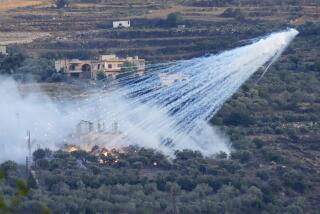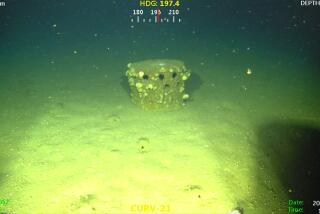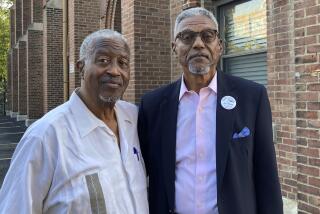The truth about WP
DESPITE EFFORTS to improve its image abroad, the United States has just suffered a damaging global propaganda defeat. And unfortunately, some of the wounds were self-inflicted.
Three weeks ago, the worldâs news media erupted into a feeding frenzy over new charges that the Americans were up to their evil old tricks. The story was all too familiar: Once again, it seemed, the United States had committed unspeakable atrocities, then lied about its illegal activities and been exposed. Every day there were fresh revelations and allegations. There is just one problem. It isnât true.
WP. Willy Pete. White phosphorus. For nearly a century, militaries around the world have used cascading showers of burning WP particles on the battlefield. It makes smoke to mark targets or hide friendly troops. It is also an incendiary weapon, used to burn enemy materiel and enemy combatants.
WP was used effectively by U.S. troops in World War II, Korea and Vietnam. It was used by the Russians in Chechnya and all sides in the former Yugoslavia. It has remained a standard part of the U.S. arsenal. The U.S. military used it in the retaking of Fallouja a year ago. It is nasty stuff, but war is nasty.
In early November, Italian state television aired a documentary about the use of white phosphorus in Fallouja. It showed video of mangled bodies said to be civilians killed by white phosphorus. The charges were sensational but, even on cursory examination, unconvincing. Nonetheless, in the days that followed, the story spread like wildfire as world news organizations gave credence to this absurdity.
The U.S. government only compounded the problem by denying that WP had been used in Fallouja for anything other than illuminating the battlefield. The government flatly rejected the charge that it had been used to burn enemy combatants. This claim, however, was untrue and easily disproved. An Army Field Artillery magazine article written earlier this year by soldiers who had fired the artillery in Fallouja described âshake and bakeâ missions -- cannons firing WP incendiary rounds along with high-explosive shells to flush out insurgents from trenches and hiding places.
As usual, it is the coverup that gets you into trouble. The guilty flee where none pursueth, but the righteous are bold as a lion.
What are the facts? What is the law?
The corpses shown in the Italian documentary had blackened skin, consistent with putrefaction after death. Their decayed condition provided no indication of the cause of death -- except that it was unlikely to have been white phosphorus. The bodies did not have the localized burns expected from WP particles, and their clothes were not burned as they would have been if they had been hit by a shower of WP particles. White phosphorus was indeed used to burn enemy combatants in Fallouja, but the unfortunates depicted in the Italian documentary probably died from some other cause.
Furthermore, the use of white phosphorus against military targets is not prohibited by any treaty. Protocol III of the Convention on Certain Conventional Weapons prohibits the use of incendiary weapons against civilian targets, to prevent future Dresdens. It also restricts the use of incendiary weapons against military targets adjacent to concentrations of civilians, but it only applies to bombs dropped from airplanes, not shells fired by artillery as was done in Fallouja. In any case, the United States has not ratified and is not bound by this protocol.
Another argument being made is that white phosphorus is an illegal chemical weapon, a poison gas. Bloggers soon found a couple of U.S. government websites containing documents that seemed to assert that WP was a chemical weapon. Closer reading revealed nothing of the sort.
Widely ignored in all this is the ultimate source authority, the Organization for the Prohibition of Chemical Weapons, which is the international agency supervising the global destruction of chemical weapons. It flatly states that ânapalm and phosphorus are not considered to be [chemical weapons] agents.â
So with no direct evidence of an atrocity, and the United States using lawful weapons, why does most of the world now believe just the contrary? And make no mistake: This slowly emerged as a story here, but it has been a big story around the world.
I was confronted with these disparate realities when I was interviewed both by CNN and CNN International a few days after the story broke. Domestic CNN, airing here in the United States, was skeptical of the scandal. CNN International, airing before an audience that had already accepted the Italian documentary as fact, took a far less skeptical approach. The two CNNs -- one for the U.S. and one for everyone else -- embodied the separate realities now occupied by the United States and the rest of the world. We see ourselves as well intentioned. Much of the rest of the world does not.
And where was the U.S. government while our reputation was dragged through more mud? Where was the State Departmentâs uber-spinmeister, Karen Hughes, all this time? U.S. officials were exacerbating the problem, providing easily debunked denials that simply stoked the feeding frenzy.
The only scandal here is that our government allowed the nation to fall victim to clumsy, cheap anti-American propaganda. At least during the Cold War, we made the Soviets work to discredit us.
JOHN PIKE is director of globalsecurity.org.
More to Read
Sign up for Essential California
The most important California stories and recommendations in your inbox every morning.
You may occasionally receive promotional content from the Los Angeles Times.










